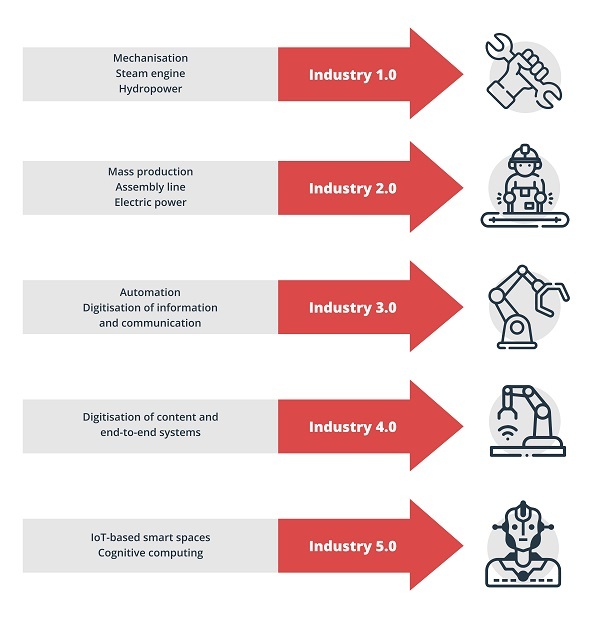Improve your systems thanks to virtual PLCs

The development of industrial environments is in constant movement and for some years now there has been a universal trend to create intelligent production configurations or fully automated factories, making it possible for communications to be 100% digital. This whole movement is known as the fourth industrial revolution or Industry 4.0.
Currently, there is a new development of industrial concepts focused on automated production through the use of industrial robots capable of performing tasks faster, more accurately and reliably than any human being. This new revolution or advance of the previous one is known as Industry 5.0. This new revolution aims to empower the industrial sector together with the Internet of Things (IoT), allowing industrial companies to combine robotic capabilities with human capabilities to obtain the best performance

- Industrial revolution along the time. Source -
In turn, Industry 5.0 seeks an improvement in the performance of the devices deployed in the plant, among which are the PLCs, essential devices in any industrial process, since they allow controlling any process in a simple and effective way. The development of these devices has been one of the most relevant aspects in the last decade, since a direct improvement on them is a direct improvement on the productive process of the company or organization.
The virtual PLC
PLCs or programmable logic controllers are electronic devices designed to control different devices through lists of programmed instructions, without the need for an operator to be continuously interacting with the industrial process.
As for the hardware and software in PLCs, both are the same, i.e., the software is installed directly in the PLC (hardware).
- Virtual PLC -
Virtual PLC are virtualized PLCs, i.e., PLCs in which both hardware and software are decoupled and are no longer on the same device, representing a new paradigm in the digital transformation of industrial processes.
The software will run on the different engineering stations throughout the factory, while the hardware will remain in a different location, thus avoiding the convergence of the two on the plant floor and providing safety, performance and cost features that regular PLCs cannot provide.
Among the most noteworthy features are the following:
- Greater flexibility: the PLC is no longer tied to the hardware, access to the controller and all controller functions (software) can be performed from any telematic device with the necessary permissions. As with PLCs, virtual PLCs have different security settings included in the software, such as access by certificate, by user and password or by restricted IP only.
- Unlimited number of sessions: the number of sessions and accesses will now be unlimited, allowing different operators, from different access points, to access the PLC easily, thus ensuring a wider range of control and data viewing possibilities.
- Seamless integration: controllers will be compatible with different software versions. Integration between IT and OT will be greater, allowing IT workers to access parts of the software easily.
- Increased efficiency: PLC centralization will now be possible thanks to PLC virtualization. The control of several PLCs from a single computer is guaranteed thanks to virtual PLCs. Costs will be considerably reduced, and workflows will be optimized.
- IT and OT merger: The virtualization or digitization of PLCs will make it possible to react more quickly and efficiently to changing requirements, such as the software used or the number of controllers, which can be adjusted quickly and easily.
- Workload: Currently, with physical PLCs, each PLC has a programming logic for an industrial process. Thanks to virtual PLCs, the control of the workload or memory of a PLC can be controlled so as not to have only the programming logic of a process, but to have the programming logic of several processes together, reducing costs (several physical PLCs are no longer necessary) and optimizing the workloads of the PLCs.
- Software cost reduction: currently, software is oversized in most industrial environments, i.e. the cost includes a number of features that in many cases will not be used. With the new virtual PLCs, the hardware is always the same, but the software is fully adaptable and expandable depending on the features required for each process, allowing organizations or companies to reduce the cost considerably.
In summary, and as a main feature, thanks to virtual PLCs, the possibility that all PLC hardware required by an industrial environment is hosted in a controlled environment (no longer a hostile environment), will improve its overall performance, increase the life cycle of the hardware and allow control over physical access to the devices. In addition to all this, there is the use of flexible software that can be implemented in any engineering station, either centrally or not, depending on the needs of the organization.
PLC vs virtual PLC
Below is a table showing the most obvious differences between PLCs and virtual PLCs:
- Differences between PLC and Virtual PLC -
Conclusions
Virtual PLCs are here to stay. The applicability of these devices is very high, their characteristics can provide different companies and organizations with the ability to have greater control over the necessary resources, lower maintenance costs due to the location of the PLC hardware in controlled environments, increase the physical security of the devices (for the same reason), improve PLC performance control and increase convergence between IT and OT environments.
Finally, it should be noted that these types of new devices, developed in industry 5.0, have to be introduced gradually in industrial environments, as their safety or performance characteristics have not been tested. Any new device, especially in ICS, has different vulnerabilities that can seriously affect the operations of the environment, and that is why its use must be controlled, although it is true that the characteristics of these virtual PLCs are promising.



